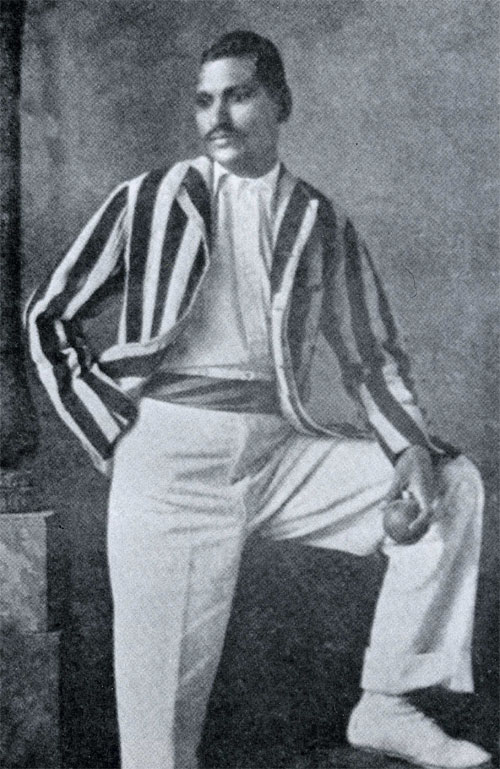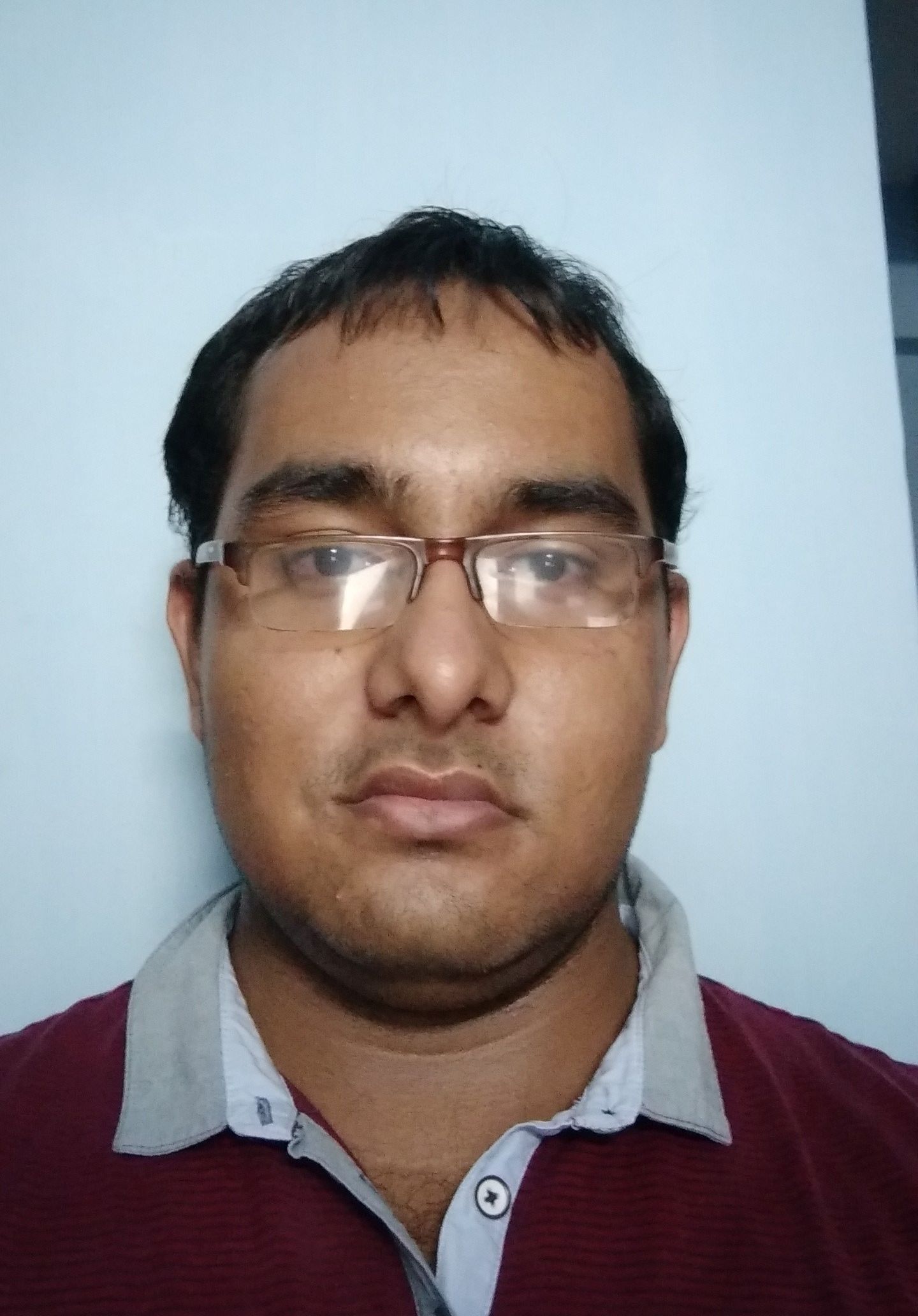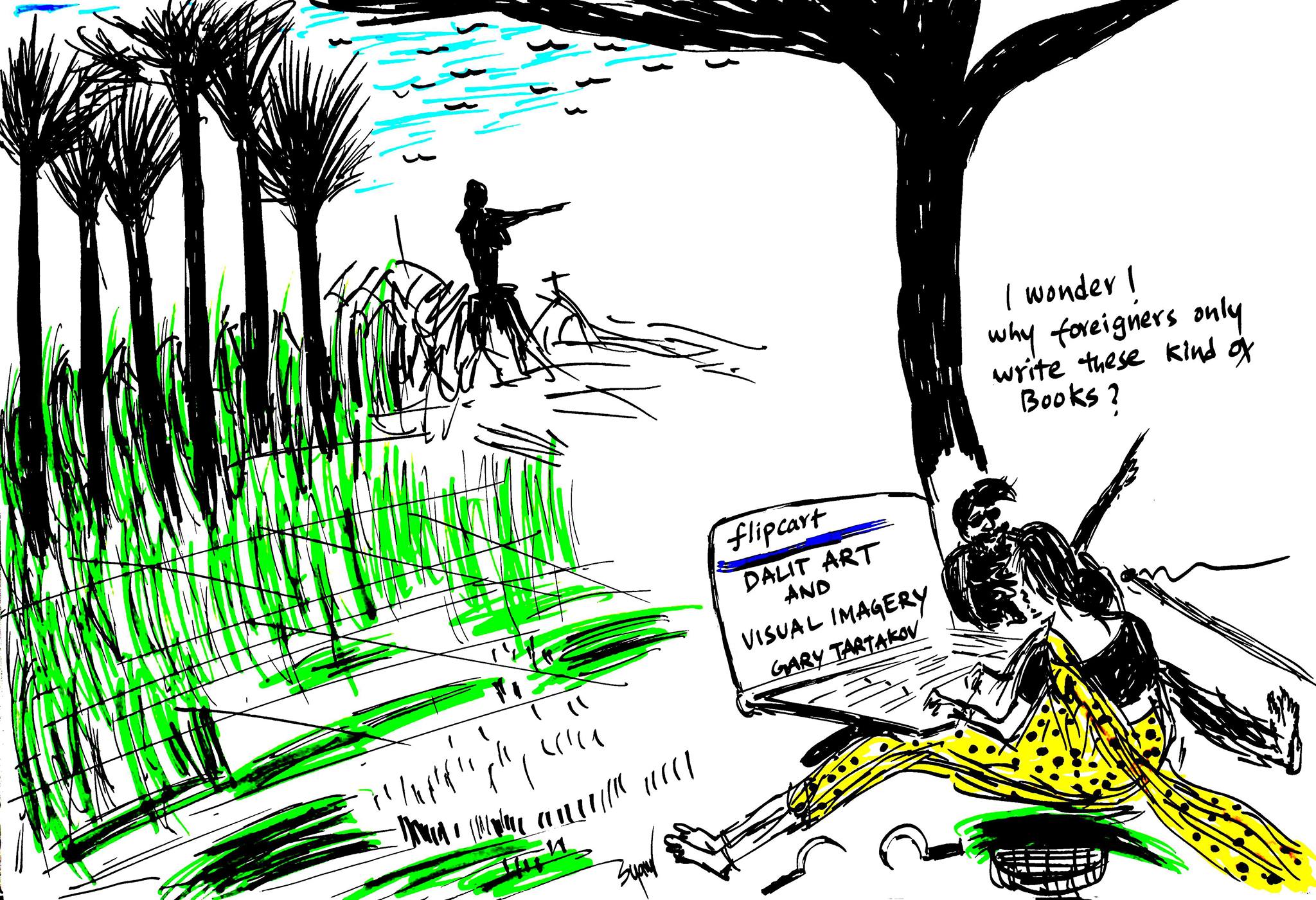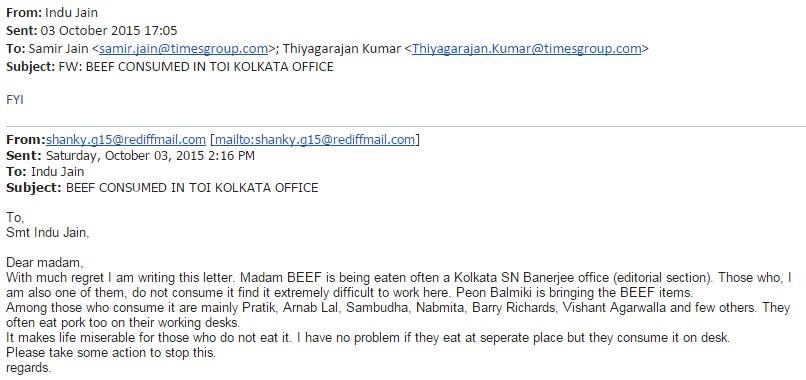Rajesh Komath
This short write-up is motivated by the recent discussions in social media on the demand for reservations in Indian cricket team, put forward by the Union Minister for Social Justice Shri. Ramdas Athawale. The Minister’s thrust of the demand was that the national cricket body BCCI should provide reservations to SC and ST sportspersons to provide equal opportunity in the international sport. He argued that “perhaps reservation to SC, ST persons in the team would have ensured better performance”. As the minister for social justice, he also affirmed that his party would vote for a move to implement reservation in cricket for SCs and STs, if the Central government comes with a similar bill in the Parliament.

Baloo Palwankar
On July 2nd, a few newspapers and online magazines carried the news both positively and negatively. The positive headlines carried were ‘Ramdas Athawale calls for reservations for SC, ST in Indian cricket team’ (Hindustan Times, July 1, 2017) ‘Ramdas Athawale demands reservations for SCs, STs in Indian cricket team’ (The New Indian Express, July 2, 2017). However, ‘Union Minister Ramdas Athawale Now Wants Reservations For SC, ST in Team India! What On Earth Is He Thinking?’ (Indiatimes, July 2, 2017, Sports) connotes the negative attitude of the media. The emphasis on ‘now wants’ might be due to the Minister’s earlier demand for separate Vidarbha state.
As the press aired the news of the demand for reservation in Indian Cricket team, Facebook pages were filled with these news tags. Many persons including my friends started abusing the Minister for demanding reservation in cricket. The nasty comments in Facebook and online newspapers reveal the intolerance to accept such a demand despite agitations against the Mandal report and much more recent articulations against reservations. Many shared trolls portraying the pictures of ‘upper castes sweeping streets, and lower castes going for government jobs’. The target was to project Dalits and Adivasis as ‘merit-less’ groups who claim for reservation to kill the country’s talent and quality.
A cursory look at the past and present of Indian cricket reveals that caste plays a significant role in Indian cricket. Cricket was brought to India during the eighteenth century by the British soldiers and sailors (Guha, 1998). Parsis of Mumbai were the first Indians who took the cricket seriously. In 1848 Oriental Cricket Club was established by Parsi youth. During the period from 1850 to 1860 around thirty Parsi cricket clubs were formed. Guha (1998) points out that the Hindus started playing the game ‘in a spirit of competitive communalism, as they had a long-standing social and business rivalry with the Parsis. In 1866, Hindu youths, of Prabhu caste formed the first Hindu cricket club. While Parsi clubs were formed by locality, Hindu cricket teams were formed on the lines of caste and religion. The names of the clubs formed during the latter part of the nineteenth century reiterate this: Gowda Saraswatha Cricket Club, Kshatriya Cricket Club etc. Muslims had also followed the same path and a Muslim cricket club was formed in Mumbai during 1883.
The story of Palwankar Baloo, India’s first Dalit cricketer, and his brothers reveals the caste discrimination in Indian cricket in the past. To quote Guha (1998):
“Baloo was a Chamaar, a member of leather-working caste which ranks close to the bottom of the Hindu social hierarchy. He was born in 1875 in Dharward, but the family moved soon afterwards to Poona, the old Maratha city hundred miles south east of Bombay. His father found work cleaning guns and cartridges in a government munitions depot, a job regarded as polluting by caste Hindus. Ironically, Baloo’s skills with the cricket ball (also made from leather) were first discovered by the British members of the Poona Gymkhana, where he worked as a servant. He bowled to the English cricketers while they practiced and word of his skill then spread to the rival Deccan Gymkhana, run and by caste Hindus. The Brahmins of the Deccan Gymkhana wished desperately to beat the British- only Poona Gymkhaana, and recruited Baloo into their fold. The Brahmins played with Baloo on the cricket field, but would not dine with him off it. In fact, during the game’s ritual ‘tea interval’ he was made to stand outside the pavilion, at a distance from his team mate, and served tea in disposable cup. What the high castes did respect was his bowling prowess, and Baloo’s services were soon canvassed by the Hindu Gymkhana of Bombay, which after ‘pacifying a few Gujarathi members, recruited him to their cricket side. In time, Baloo was followed by his brothers Shivaram, Ganpat and Vithal, all prodigiously gifted cricketers. Baloo and Shivaram both played a vital part in the victory of February 1906 over Europeans. In the match, Baloo took eight wickets in the two innings.”
Even though Baloo’s performances were incredible, caste prejudice became a hurdle in making Baloo captain of the Hindus. Baloo was dropped from the team. His brothers, Vithal and Shivaram, withdrew from the team in protest. The public statement they released reflects their restrained anguish. To quote Guha (1998):
“It need hardly be said that the claims of one of us are superior to those of Mr. Deodhar, and the (Hindu Selection) Committee’s decision can only be characterised as unsportsmanlike in the extreme, in as much as they have apparently been influenced by the caste and social and educational status of their selection rather than his achievements or seniority in the field of cricket, and as such the committee’s decision can only be taken as partial with a bias in favour of caste. Social or educational status has no place in the sport when the claims of a cricketer of lesser social status are admittedly superior…. In arriving at this decision (not to play) we feel very strongly the covert or overt insult levelled at us as belonging to the so-called depressed class as it amounts to a nullification of our claims for recognition for all time. That such matters as caste should be the determining factor in Cricket is more than we can quietly bow down to, hence our decision to stand down from the Hindu Team this year.”
A lot has changed in the Indian polity, but it is doubtful whether cricket, has been able to elude the handcuffs of caste. In 2008 Board of Control for Cricket in India (BCCI) proposed caste based selection policy for Indian cricket team. The then BCCI secretary Mr. Niranjan Shah asserted that BCCI studied the success of South Africa’s positive discrimination selection policy. Similar policy measure is needed for the upliftment of minority and backward communities in India. Every 15 man Indian squad should include at least 7 players from SC/ST and other backward castes. However nothing happened, we have to assume that the proposal didn’t get approval from the cricket community and got torpedoed.
Brahmins control cricket. If we analyse the caste composition of the past and present Indian cricketers, we can come to the conviction that Indian Cricket Team is dominated by Brahmins and other upper castes. Sunil Gavaskar, Sourav Ganguly, Ravi Shastri, Rahul Dravid, Anil Kumble, Sachin Tendulkar, Javagal Srinath, Ajit Wadekar, Vinoo Mankad, G.R.Vishwanath, Ishant Sharma, E. A. S. Prasanna, Chetan Sharma, Yashpal Sharma, B Chandrasekhar, K Srikanth, Rohit Sharma, Sunil Joshi, Venkatesh Prasad, V.V.S. Laxman, Ashok Malhotra, Sreeshashant, Murli Karthik, Sanjay Manjrekar etc.
In order to make cricket more national in character, it has to become more representative in nature. Why is there such high Brahmin representation in Indian cricket teams? Are Brahmins a majority in India? Do Brahmins represent the Indian nation? If the answers are no, then there is a relevance in the demand of the minister who argues for representation of Dalits in Indian cricket. If you ask questions such as why do Brahmins dominate in Indian cricket, then the base-superstructure synthesis of Karl Marx will help us to understand the material process involved in making a cricketer. How does the base help a certain social group to easily enter into the superstructures of hegemony that work in our society which is primarily caste-ridden than caste?
Statements and conflicts of opinions that appeared in Facebook are used here as evidence to shed light on the intolerance of upper class/castes on the matter of reservations in cricket. Mr. A, a highly respected person wrote in his Facebook by tagging the link: Union Minister Ramdas Athawale Now Wants Reservations For SC, ST in Team India! What On Earth Is He Thinking?’
“The length of the cricket pitch for the beneficiaries of Ramdas Athawale’s proposal should be reduced to 75 percent and each run scored by them should be counted as 1.25 runs”.
According to him, the reservation policy in Indian cricket will water down the meritocracy of players. The policy of reservation doesn’t change the rules of the game and it gives preference only at the entry point. Despite knowing these facts his post reflects caste prejudices. He questions the whole notion of the policy of reservation and reduces it to the ‘mechanism for an accommodation of less qualified persons’.
A post from Mr. B, a well educated and well placed man reads:
“What a joker. I want to play for India too”.
Facebook acts a platform of the network, where one can present their views on social and political issues. The general attack on reservation in facebook posts gives an impression that ‘reservation is bad and should be stopped from all spheres. A self-reflexive thought about oneself in respect to caste, class, and lineage would make many realize that caste still continues with them and that is why certain traditional doxa work in them which shape their opinions too. However, it is not possible to teach everyone, every time what is self-reflexology, transparency and democratic?
I replied to his post:
“My dear sir, there are many from these communities deprived of opportunities due to caste prejudices of the board. Vinod Kambly was a good player. He was a victim of Brahmin dominance in the group. Why is Indian cricket fully dominated by Brahmins only? Do you think that it is simply merited? why not others? forget about SCs and STs. His [Minister] argument is for creating opportunities and get rid of Brahmin dominance in cricket. You people can only mock at it. To understand the intensity of exclusion in these fields you should have social sensitivity or to born in an untouchable family”.
Responding to the supporters, I had again pointed out:
“How do you people acquire a skill. Is it hereditary? If so, why all your fathers and forefathers became so skillful? You have good access to resources. Whose resources were this? You have accumulated it not even proper way. So do not make me to narrate stories of exploitation and creating your so-called skills. it is not to cutting short of length of a screen or runs taken. It is to give opportunity. Then see what it is. Even if they fail, there is an aspect of social justice”.
As the reply to my comment, Mr. A posted :
“I do not want to enter into an argument with someone (1) who cannot take a joke (2) whose view of everything – and I mean EVERY THING – is coloured and prejudiced by caste (3) who seems to believe that the deprived belong only to one caste and (4) who, in his bid to win an argument, resorts to badmouthing the parentage and lineage of the ‘opponent’. I rest my case on that note”.
How can we discuss caste without looking at the lineage of a person? How is merit produced? If we go deeply as self-reflexive people, we have to admit this lineage influences our views.

Vinod Kambli
It is interesting to further note that I was blamed as a person who is not able to understand a joke. I was further attacked that I am seeing everything in the gaze of caste. I am sure that caste is one category through which one can understand social behavior and social interaction that is defined most of our life. There are two dimensions to it. Generally, human beings have a tendency to discriminate against others irrespective of caste or class, which is termed as a ‘taste for discrimination’. This works out of the ‘accumulated privilege’ of people on others. Secondly, there is an aspect of ‘statistical discrimination’ which comes out of the asymmetrical information one has about others, I mean what others think about something and the social and economic problems that they face in a given context. Here a kind of stigma of incompetence is thrust on Dalits in spheres of competition. Dalits were always part of jokes. Joking on a social group without considering their experiences of historical injustice by upper castes – this displays their taste for discrimination. This is the general tendency of the upper castes which has developed from the beginning of their social life and it turns into a doxa, means unquestioned beliefs about certain social facts.
It is also interesting to look into the aspects of following comments from Facebook in a similar context. To quote:
“This is NOT in response to any comment. I believe that the disadvantaged -based on gender, religion, caste, social status, whatever – deserve all support in the form of education, training, and skill development. Period after that, it has to be meritocracy. The self-esteem of the disadvantaged will get a boost only when they compete in a level playing field. I personally know someone who, having become a bank officer, declined all benefits he was entitled to as a member of the weaker segment. His logic: I am the beneficiary of reservation; my children do not need those crutches – let another family benefit. My salutes to him. (I am told the former DGP (Director General of Police) of Kerala Mr T P Senkumar too refused the props of reservation.) Do many reservation beneficiaries have the integrity to emulate him?”
Although it is a completely different question that depends on the personal choice of a person, popular images of the upper castes on reservation is this. All those ‘rights’ to be avoided to benefit another family. This brings forth the economic dimension of reservation. The principle of reservation is not based on economic criteria, it is primarily social. This ‘social aspect’ is crucial to have a debate on reservation. It not only deals with the present, but it also takes into account the history, historical injustice experienced and the perpetuation of inequality and discrimination in the present. The mentality against reservation is a doxa carried forward from history and lineages.
The notion that caste ties, birthright will guarantee a job, a position, is largely gone should be taken with a heavy dose of salt. As rightly said in the oft-cited paper of Kirschenman and Neckermann (1991), We’d Love to have them in Cricket…..But…That But is the answer to all the questions. To me, cricket is like what George Bernard Shaw once observed: “Cricket is a game where eleven fools play and eleven hundred fools watch”. But my point is that it is a game more hegemonic in nature.
I can put it in these words. “Cricket is a game where eleven Brahmins and upper castes play and eleven million sarvajan and bahujan fools watch and eleven hundred fools in the upper caste media comment and analyse.” But, the question of giving the opportunity to everyone and to make it more representative is important to make the nation more democratic in all spheres of life. It wards off caste prejudices, the most important path is to recognise that caste permeates all field of social relations, analyse it and then annihilate it. Blindly taking a position against reservation comes out of ‘common sense’ that has its roots in lineages and past. To fight against caste and to make Indian society more democratic, we need to think beyond common sense, taking the past and contemporary discourses of caste into account. The opinions shared in social media should not be a humiliation to a social group who were historically the subject of injustices based on social ordering.
~~~
Rajesh Komath (komathrajesh@gmail.com) is an Assistant Professor of Social Sciences, School of Social Sciences, Mahatma Gandhi University, Kottayam, Kerala.










